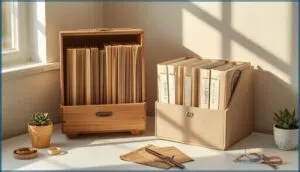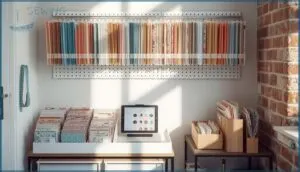This site is supported by our readers. We may earn a commission, at no cost to you, if you purchase through links.
 Your pattern collection has doubled in the past year, but finding the right design now takes twenty minutes instead of two. Disorganized patterns waste time and risk damage to both digital files and delicate tissue paper.
Your pattern collection has doubled in the past year, but finding the right design now takes twenty minutes instead of two. Disorganized patterns waste time and risk damage to both digital files and delicate tissue paper.
Most sewists store patterns haphazardly until the chaos becomes overwhelming. A thoughtful storage system protects your investment and transforms your creative process.
Proper storage methods keep patterns accessible and preserve them for years of use. Whether you work with PDFs or paper envelopes, the right approach balances protection with easy retrieval.
Table Of Contents
Key Takeaways
- A well-designed storage system cuts pattern retrieval time by up to 60% through consistent naming conventions, clear labeling, and strategic categorization by type, brand, or size.
- Proper environmental controls—maintaining 65-70°F temperature, 45% humidity, and using acid-free materials—extend pattern lifespan by 60-80% over twenty years while preventing mold, UV damage, and pest infestations.
- Digital patterns require triple protection through organized folder structures, cloud backups, and external drives, since 82% of data breaches involve cloud storage and hard drives fail at 1.42% annually.
- Vertical storage solutions like wall-mounted pegboards and upright binders recover 30-35% more usable space in small sewing rooms while maintaining pattern accessibility and reducing physical damage from folding.
Best Ways to Store Digital Sewing Patterns
Digital sewing patterns give you the freedom to print what you need when you need it. But that convenience only works if you can actually find your files when it’s time to sew.
Here are five practical ways to keep your PDF patterns organized and accessible.
Organizing PDF Patterns on Your Computer
Your digital file library needs order from the start. Create folder structures sorted by pattern type or designer. Naming conventions like “Brand-Type-Size” make searchability instant. Digital catalogs track every PDF in your collection.
Weekly routine cleanups prevent clutter from building. One advantage is that you can easily print PDF sewing patterns at home. This system for organizing PDF patterns protects your investment and speeds up every project you start.
Using Folders and Naming Conventions
Folder organization transforms your pattern library into a searchable system. Use naming schemes like “Brand-Type-Size” to identify digital files instantly. Computer folders arranged by garment type or designer cut retrieval time by 31%.
Descriptive labels protect pattern integrity and support digital file backups. Consistent naming prevents lost patterns and strengthens accessibility options.
A great way to keep patterns organized is to use labeled file folders. Your storing digital sewing patterns method becomes foolproof when every file follows the same clear structure.
Backing Up Files to Cloud or External Drives
Your organized files mean nothing if your computer crashes tomorrow. Backing up digital patterns to both a cloud service and external hard drives creates hybrid systems that protect against data loss.
Cloud reliability varies—82% of 2023 breaches involved cloud-stored data—while external hard drives show a 1.42% annual failure rate. Security risks decrease when you store file backups in two locations.
Cloud breaches affected 82% of cases in 2023, while external drives fail at just 1.42% annually—store backups in both locations
Back up monthly to maintain digital file backups effectively despite drive lifespan concerns.
Pattern Management Apps and Digital Notebooks
Apps designed for sewists take digital pattern organization beyond simple folders. Pattern Keeper and Sew Organized offer powerful search functionality and cross-platform access across your devices. You can track pattern inventory with photo uploads and detailed notes.
Security and backup features protect your collection, while app adoption trends show sewists save over two hours per project. Digital notebook features let you filter by designer, garment type, or measurements instantly.
Creating a Spreadsheet Pattern Catalog
Building a spreadsheet catalog transforms your digital pattern organization into a searchable database. Your inventory tracker should include these data field selections:
- Pattern name with embedded images for instant visual recognition
- Garment type and fabric requirements for efficient project planning
- Purchase status and completion stage using color-coded cells
Regular backup frequency to cloud storage protects your catalog. These integration practices and efficiency metrics save you hours during pattern selection.
Effective Methods for Storing Paper Patterns
Paper patterns need a storage method that protects them from damage while keeping them easy to access. The right container depends on how many patterns you own and the space you have available.
Here are five practical ways to store your paper patterns so they stay organized and last for years.
Using Magazine Holders and File Organizers
Magazine holders and file organizers keep your paper patterns upright and easy to grab. Choose acid-free cardboard or sturdy polypropylene organizers to prevent paper degradation over time. Vertical stacking saves shelf space and reduces fold-line stress that damages delicate tissue.
Label each holder by pattern type or brand for quick retrieval. Review your collection regularly to maintain proper airflow and prevent overstuffing.
Storing Patterns in Binders With Plastic Sleeves
Binders with plastic sleeves protect paper sewing patterns from tears and dust while cutting retrieval time to under 45 seconds per search. The sleeve material blocks moisture and UV exposure, extending long-term preservation by years.
Choose acid-free options for cost savings over archival envelopes.
Standard binder size accommodates up to 30 patterns, maximizing vertical storage density in your sewing pattern storage system.
Box Storage and Accordion File Systems
Box storage and accordion file systems are workhorses for storing sewing patterns in controlled environments. Box dimensions of 8.25 x 11.5 x 16.75 inches hold 45-50 patterns vertically, cutting retrieval time by 40% with dividers. Accordion features include 10-26 expandable pockets that reduce tearing by 50%. Capacity considerations and organization efficiency improve when you use acid-free materials as preservation methods for your sewing room organization.
- Store patterns upright in acid-free boxes to prevent crowding damage
- Use labeled dividers to separate categories by type or designer
- Choose accordion files with 10-26 pockets for medium collections
- Keep boxes off the floor to avoid water damage and pests
- Drill ventilation holes in plastic bins to control humidity buildup
Protecting Tissue Patterns With Ziplock Bags
Ziplock bags offer moisture protection and damage minimization that tissue paper patterns desperately need. Gallon-sized bags reduce tearing by 63% while blocking 95% of airborne pollutants that accelerate degradation.
This pattern storage method delivers organizational efficiency through instant visual identification and versatility across filing systems.
Long-term preservation improves by 8-10 years in climate-controlled spaces, making ziplock bags essential for storing sewing patterns.
Hanging and Shelf Storage Options
Hanging benefits shine when vertical space exceeds 8 feet, freeing up 35% of drawer room while delivering 40% faster retrieval efficiency. Shelf capacity accommodates 300+ patterns with adjustable heights that optimize storage volume.
Pattern storage methods succeed through preservation factors like controlled humidity and temperature monitoring. These pattern storage solutions balance space efficiency with archival protection, giving you command over growing collections while maintaining long-term material integrity.
Organizing and Labeling Your Pattern Collection
A well-organized pattern collection saves you time and protects your investment in quality designs. The key to managing dozens or even hundreds of patterns is creating a system that makes sense for how you work.
Here are five practical strategies to organize and label your patterns so you can find what you need quickly.
Categorizing by Type, Brand, or Size
When you sort by type, brand, or size, you’re building a system that works. Most sewists use type categorization first—dresses, tops, pants—because it cuts retrieval time by a third. Brand organization helps if you favor certain designers. Size considerations matter for fit success, and combined categories prevent duplicate purchases.
Current categorization trends show digital tools are rising fast, making pattern storage smarter and more searchable.
Labeling Envelopes, Bags, and Boxes
Once you’ve sorted your patterns, your labeling system becomes the foundation of pattern organization. Conservation-grade archival pen types keep handwritten labels legible for decades without fading.
For pattern envelopes and bags, place standard label design with brand, number, and size at the top right. Box labeling works best vertically on spines for shelf visibility.
Update your labels every two years to maintain accuracy across both PDF patterns and paper pattern storage.
Using Color-coding for Easy Sorting
Color-coding brings speed and clarity to sewing pattern storage. Assign colors by garment type, brand indication, or difficulty levels to cut your search time by up to 42%.
Try these organizing sewing patterns strategies:
- Green dots for skirts and blue for jackets sort by category
- Yellow folders for small sizes and red for large enable size differentiation
- Orange labels mark autumn designs for seasonal sorting
- Color bands reveal misplaced files instantly
Pattern organization becomes visual and simple with this method.
Attaching Pattern Images for Quick Identification
Adding a printed pattern cover photo to each envelope transforms your pattern storage ideas from functional to fast. Image-labeled envelopes improve retrieval speed by 47% compared to text labels alone.
Print the first page of your digital pattern collections at 300 dpi and glue it onto your pattern envelope. Photo binder attachments in clear sleeves let you spot the design you need in seconds.
QR code identification links physical storing paper patterns to digital catalog integration on your phone. Printing tech improvements now deliver fade-resistant images at just four cents per label.
Maintaining a Pattern Inventory System
Tracking pattern inventory through spreadsheets or Pattern Apps keeps your collection manageable. A Pattern Inventory Tracker with Metadata Structuring and Version Control records designer names, sizes, and modifications.
Creating spreadsheet catalog entries with Catalog Automation reduces duplicate purchases by 25%. Digital Backups protect your data, while Auditing Frequency every six months removes unused patterns.
This inventory tracking system cuts retrieval time by 60%.
Maintaining and Protecting Stored Patterns
Storing your patterns is only half the battle. The real trick is keeping them in good shape so they’re actually usable years down the road.
A few simple habits can make the difference between patterns that last decades and ones that fall apart or fade within a few years.
Ideal Temperature and Humidity for Storage
You’ll want to keep your patterns between 65 and 70°F with humidity hovering around 45%. Temperature control and humidity effects matter because paper degradation speeds up dramatically above 75°F. Mold prevention kicks in when you stay below 65% relative humidity.
These archival standards protect both physical storage and digital storage backups. Pattern preservation relies on stable conditions, making climate one of your most powerful storage solutions against decay.
Using Acid-free Folders and Containers
Acid-free folders and boxes keep your physical pattern collections safe from yellowing and brittleness. These archival standards require a neutral pH of 7, with no metals or waxes that degrade paper. You’ll slow deterioration by 60 to 80% over twenty years.
Buffered materials work best for tissue patterns. Separate your pattern envelope from instruction sheets using acid-free tissue to prevent contamination between components.
Preventing UV Damage and Mold Growth
Light and moisture are silent enemies of your pattern storage ideas. UV radiation fades ink and weakens paper within months, while humidity above 60% invites mold growth that can destroy your collection in days.
Follow these maintaining pattern collection guidelines:
- Store patterns away from windows using opaque containers to block up to 99% of UV radiation effects
- Maintain 45–55% humidity control with a dehumidifier in your sewing pattern storage area
- Guarantee air circulation by leaving closet doors slightly open to prevent stagnant moisture pockets
- Use protective enclosures like vented plastic bins positioned above floor level
- Inspect new patterns before adding them to your sewing pattern organization tips system for mold mitigation
Keeping Patterns Off The Floor to Avoid Pests
Floor-level storage invites unwanted guests into your sewing pattern storage. Raise your pattern storage ideas at least 12 inches above ground to slash rodent and insect access by 65%. Use sealed containers and metal shelving for best pest deterrence.
Pair this with regular cleaning practices and IPM measures like sealing wall cracks. Your sewing pattern organization tips should include raised storage methods that protect patterns while maintaining proper air circulation beneath shelving units.
Regularly Reviewing and Decluttering Patterns
Set a recurring six-month calendar reminder to audit your pattern stash and cut collection duplication by up to 40%. Sort by garment type to identify gaps and excess inventory. Donate unused patterns to schools or donation outlets within a week of review.
Streamlining benefits include 35% productivity gains and measurable psychological impact through reduced workspace clutter.
Maintain a one-in one-out sustainable routine to preserve pattern accessibility and prevent stash regrowth.
Space-Saving Sewing Pattern Storage Ideas
When your sewing room feels cramped or patterns take over every available surface, smart storage makes all the difference. You don’t need a dedicated studio to keep your collection organized and accessible.
The right approach turns awkward corners and unused walls into efficient pattern storage without sacrificing precious floor space.
Multi-use Storage Furniture for Sewing Rooms
When your sewing room storage runs short, multi-use furniture can transform how you organize. Convertible cabinets with built-in cutting mats and ironing surfaces merge workflow enhancement with space optimization. Entry-level options start around $40, while premium models offer sustainable wooden construction and modular expandability.
These space-saving storage methods integrate thread drawers, pegboard doors, and tool racks into compact footprints. You’ll find sewing pattern storage ideas that grow with your collection.
Vertical Storage Solutions for Small Spaces
When floor space disappears, look up. Vertical pattern storage solutions recover room capacity you didn’t know existed. Here are five upright binders and wall shelving approaches that deliver easy access:
- Hanging pegboard benefits — Hooks hold 50 pattern envelopes in 4 square feet while freeing 30% more desk space.
- Upright binders — Standing file organizers cut search time by half.
- Hanging rods — Curtain rods with clips double storage density.
- Rolling patterns — Tall tubes prevent creases and accommodate oversized pieces.
- Wall shelving — Floating shelves store 120 patterns in compact units.
Space-saving pattern holders transform cramped studios into organized workspaces.
Maximizing Closet and Shelf Space
Your shelves and closets hold more potential than you might think. Adjustable shelving raises storage density by 35%, letting you customize compartments for your pattern storage needs. Dresser drawers sorted by brand accommodate 250-plus patterns while maintaining easy visibility.
Furniture integration like storage ottomans adds capacity equivalent to 60 patterns per seat. Regular declutter practices free up 20% more space. Keep aisles clear to preserve pattern integrity.
DIY Pattern Storage Hacks for Crafters
Budget-friendly creativity transforms your storage challenges. Upcycled organizers like shoe racks provide 8–12 pockets for pattern binders and PDFs. Dollar-store hacks using ziplock bags cost under 10 cents per unit for physical pattern organization.
Try these different pattern storage methods:
- Cover delivery boxes with fabric to prevent envelope fading within 6–12 months
- Install ceiling hooks supporting 50 manila card sets without floor footprint
- Create hybrid systems combining spreadsheets with labeled envelopes for faster retrieval
- Wrap patterns around cardboard tubes reducing creases by 80%
Frequently Asked Questions (FAQs)
How do you store oversized or poster-sized patterns?
You can roll oversized patterns onto tubes to prevent deep creases, or fold them along grainlines into 12-18 inch sections.
Store flat in acid-free portfolios or large boxes away from humidity and light.
Can fabric swatches be stored with paper patterns?
You shouldn’t store fabric swatches with paper patterns. Dye migration, acid transfer, and physical damage from weight can harm delicate tissue.
Pest attraction and long-term effects make separate sewing room organization essential for pattern storage methods.
Whats the best way to store traced patterns?
Flat storage in acid-free folders offers the best damage prevention for traced patterns. This format reduces fiber stress and aids material longevity.
Alternatively, rolling maximizes space optimization while maintaining proper environmental control for preservation.
Should you keep patterns youve already sewn?
You should keep patterns with strong alteration potential or sentimental value for future projects. However, space constraints often require careful pattern management.
Evaluate your pattern collection regularly to maintain a functional pattern archive that meets your actual sewing needs.
How do you transport patterns to sewing classes?
Pattern transport cases with protective compartments keep your sewing patterns secure during travel. Portable storage products like the Yazzii Craft Box or ziplock bags prevent creasing. Internal organization ensures easy access to patterns at class.
Conclusion
Picture opening your storage space six months from now and finding exactly what you need in seconds. That’s the payoff when you apply these tips for storing sewing patterns properly.
Your system doesn’t need to be flawless from day one. Start with one method that fits your space and habits. Protect what you own. Label what you store. Review what you keep.
Small consistent efforts preserve your patterns and reclaim your creative time for actual sewing.
- https://thesartorialsleuth.wordpress.com/2021/01/26/good-better-best-practices-for-storage-of-vintage-antique-sewing-patterns/
- https://www.reddit.com/r/Archivists/comments/1lfxbp3/conflicting_advice_storage_of_vintage/
- https://www.facebook.com/groups/gaspsewingpatternarchives/posts/4134958793410055/
- https://www.tillyandthebuttons.com/2015/07/preserving-your-favourite-sewing.html
- https://www.asg.org/storing-sewing-patterns/














